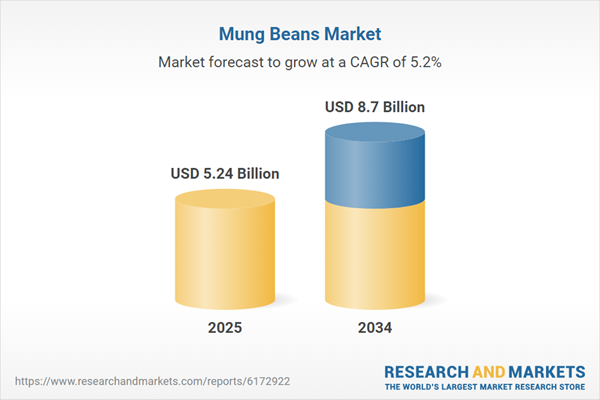The global mung beans market is being driven by the growing vegan population, leading to increased demand from the vegan populace, coupled with the rising consumer demand for organic and nutritious food products. The rising consumer awareness regarding health and wellbeing is driving this trend.
Country-wise, India is the leading mung beans producer, accounting for approximately 60% of its total global production, followed by China and Myanmar. The cultivation of the product and consumption have been taking place in South Asia since ancient times, owing to the presence of favourable climatic conditions in the region. In the past few years, they have made their way across Europe and the United States. Thus, the steadily growing demand for plant-based food products in regions like North America and Europe is expected to provide an impetus to the industry growth in the forecast period.
Properties and Applications
Mung beans, also known as the green gram or moong, are a plant species belonging to the family of legumes. They are widely cultivated in warm regions, including East Asia, Southeast Asia, and the Indian subcontinent, for its edible usually green or yellow seeds, forage, and as a major source of bean sprouts. They are rich in protein, fibre, folate, and other, and provide several health benefits. They are used as an ingredient in both savoury and sweet dishes, particularly in the above-mentioned regions. In India, they are consumed as a part of the staple diet.Owing to their easily digestible nature, they are appropriate for people of every age. They can be either cooked or sprouted for their consumption. As a result of their high nutritional value, they are witnessing a rise in its demand.
Market Segmentation
The Expert Market Research’s report titled “Mung Beans Market Report and Forecast 2025-2034” offers a detailed analysis of the market based on the following segments:Market Breakup by End Use
- Hosuehold
- HoReCa
Market Breakup by Region:
- North America
- Europe
- Asia-Pacific
- Latin America
- Middle East and Africa
Market Analysis
The global mung beans market is being driven by the growing consumer awareness regarding the benefits of the consumption of the product. The health-conscious consumers are increasingly incorporating mung beans into their diets as they are an excellent source of proteins, fibres, vitamins, minerals, phytoestrogens, and antioxidants. It has been found that mung beans are helpful in preventing and controlling certain health issues like diabetes, heart diseases, anaemia, and cancer, thus, leading to its increased adoption by consumers.Rising awareness among farmers regarding modern farming methods and practices, particularly in emerging nations like India, is leading to improved cultivation and high yields of mung beans. Growing government support, aiming to aid the farmers with the launch of several programmes and subsidy policies, is expected to contribute significantly to the industry's growth.
With rising disposable incomes and growing consumer focus on health and wellness, the industry is witnessing increased growth. The incorporation of mung beans in other food products by consumers, as well as manufacturers, are providing a boost to the industry. The growing focus of manufacturers to launch plant-based food products, fulfilling the surging demand from the vegan populace, is expected to result in new trials, which will further aid the industry growth over the forecast period.
The report gives a detailed analysis of the key players in the global mung beans market, covering their competitive landscape, capacity, and latest developments like mergers, acquisitions, and investments, expansions of capacity, and plant turnarounds. The comprehensive report provides an in-depth assessment of the market based on the Porter's five forces model along with giving a SWOT analysis.
Table of Contents
Table Information
| Report Attribute | Details |
|---|---|
| No. of Pages | 178 |
| Published | August 2025 |
| Forecast Period | 2025 - 2034 |
| Estimated Market Value ( USD | $ 5.24 Billion |
| Forecasted Market Value ( USD | $ 8.7 Billion |
| Compound Annual Growth Rate | 5.2% |
| Regions Covered | Global |









